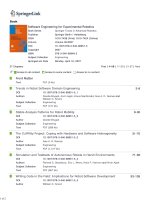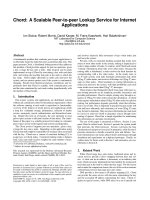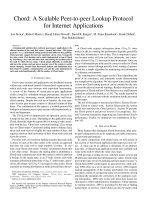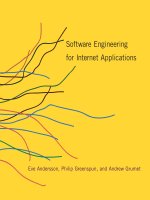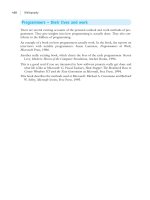software engineering for internet applications
Bạn đang xem bản rút gọn của tài liệu. Xem và tải ngay bản đầy đủ của tài liệu tại đây (3.9 MB, 411 trang )
Software Engineering
for Internet Applications
Eve Andersson, Philip Greenspun, and Andrew Grumet
After completing this self-contained course on server-based Internet applications software, students who
start with only the knowledge of how to write and debug a computer program will have learned how to build
Web-based applications on the scale of Amazon.com. Unlike the desktop applications that most students
have already learned to build, server-based applications have multiple simultaneous users. This fact, coupled
with the unreliability of networks, gives rise to the problems of concurrency and transactions, which students
learn to manage by using the relational database system.
After working their way to the end of the book, students will have the skills to take vague and ambitious
specifications and turn them into a system design that can be built and launched in a few months. They
will be able to test prototypes with end-users and refine the application design. They will understand how
to meet the challenge of extreme business requirements with automatic code generation and the use of open-
source toolkits where appropriate. Students will understand HTTP, HTML, SQL, mobile browsers, VoiceXML,
data modeling, page flow and interaction design, server-side scripting, and usability analysis.
The book, which originated as the text for an MIT course, is suitable for classroom use and will be a useful
reference for software professionals developing multi-user Internet applications. It will also help managers
evaluate such commercial software as Microsoft Sharepoint of Microsoft Content Management Server.
Eve Andersson is Senior Vice President and Chair of the Bachelor of Science in Computer Science at Neumont
University, Salt Lake City.
Philip Greenspun, a software developer, author, teacher, pilot, and photographer,
originated the Software Engineering for Internet Applications course at MIT. He is the author of
Philip and
Alex’s Guide to Web Publishing
. Andrew Grumet received his Ph.D. in Electrical Engineering and Computer
Science from MIT and builds Web applications as an independent software developer.
Software Engineering for Internet Applications Eve Andersson
Philip Greenspun
Andrew Grumet
Andersson, Greenspun, and Grumet
Software Engin
eering for Interne
t Applications
“Filled with practical advice for elegant and effective Web sites.”
—
Edward Tufte, author of The Visual Display of Quantitative Information
computer science/software engineering
0-262-51191-6
The MIT Press
Massachusetts Institute of Technology
Cambridge, Massachusetts 02142
Cover design by Erin Hasley
Software Engineering for Internet
Applications
Eve Andersson, Philip Greenspun, and Andrew Grumet
Software Engineering for Internet
Applications
The MIT Press
Cambridge, Massachusetts
London, England
6 2006 Massachusetts Institute of Technology
All rights reserved. No part of this book may be reproduced in any form by any elec-
tronic or mechanical means (including photocopying, recording, or information storage
and retrieval) without permission in writing from the publisher.
MIT Press books may be purchased at special quantity discounts for business or sales
promotional use. For information, please email or write
to Special Sales Department, The MIT Press, 55 Hayward Street, Cambridge, MA
02142.
This book was set in Times New Roman on 3B2 by Asco Typesetters, Hong Kong, and
printed and bound in the United States of America.
Library of Congress Cataloging-in-Publication Data
Andersson, Eve Astrid.
Software engineering for Internet applications / Eve Andersson, Philip Greenspun, and
Andrew Grumet.
p. cm.
Includes bibliographical references and index.
ISBN 0-262-51191-6 (pbk. : alk. paper)
1. Internet programming. 2. Application software. 3. Software engineering. I.
Greenspun, Philip. II. Grumet, Andrew. III. Title.
QA76.625.A55 2006 005.2
0
76—dc22 2005049144
10987654321
Contents
Preface vii
Acknowledgments ix
1 Introduction 1
2 Basics 9
3 Planning 47
4 Software Structure 63
5 User Registration and Management 75
6 Content Management 97
7 Software Modularity 141
8 Discussion 161
9 Adding Mobile Users to Your Community 183
10 Voice (VoiceXML) 199
11 Scaling Gracefully 213
12 Search 241
13 Planning Redux 261
14 Distributed Computing with HTTP, XML, SOAP, and WSDL 269
15 Metadata (and Automatic Code Generation) 281
16 User Activity Analysis 303
17 Writeup 313
Reference Chapters
A HTML 329
B Engagement Management by Cesar Brea 351
C Grading Standards 359
Glossary 363
To the Instructor 375
Sample Contract (between Student Team and Client) 391
About the Authors 393
Index 395
vi Contents
Preface
This is the textbook for the MIT course ‘‘Softw are Engineering for Internet
Applications.’’ The course is intended for juniors and seniors in computer
science. We assume that they know how to write a computer program and
debug it. We do not assume knowledge of any particular programming lan-
guages, standards, or protocols. The most concise statement of the course
goal is that ‘‘The student finishes knowing how to build amazon.com by him
or herself.’’
Other people who might find this book useful include the following:
m
professional software developers building online communities or other multi-
user Internet applications
m
managers who are evaluating packaged software aimed at supporting online
communities—various chapters contain criteria for judging the features of
products such as Microsoft Sharepoint or Microsoft Content Management
Server
m
university students and faculty looking to add some structure to a ‘‘capstone’’
project at the end of a computer science degree
If you’re confuse d by the ‘‘student knows how to build amazon.com’’ state-
ment, we can break it down in terms of principles and skills. The fundamental
di¤erence between server-based Internet applications and the desktop appli-
cations that students have already learned to build is that server-based appli-
cations have multiple simultaneous users. Coupled with the unreliability of
networks, this gives rise to the problems of concurrency and transactions.
Stateless communications protocols such as HTTP mean that the student must
learn how to build a stateful user experience on top of stateless protocols. For
persistence between clicks and management of concurrency and transactions,
the student needs to learn how to use the relational database management sys-
tem. Finally, though this goes bey ond the simple stand-alone amazon.com-style
service, students ought to learn about object-oriented distribute d computing
where each object is a Web service.
In addition to learning these principles, we’d like the student to learn some
skills. This is a laboratory course, and we want students who graduate to be
competent software engineers. We’d like our students to be able to take vague
and ambitious specifications and turn them into a system design that can be
built and launched within a few months, with the features most important to
users and easiest to develop built first and the di‰cult bells and whistles de-
ferred to a second version. We’d like our students to know how to test proto-
types with end-users and refine their application design once or twice within
even a three-month project. When business requirements are extreme, for
example, ‘‘build me amazon.com by yourself in three months,’’ we want our
students to understand how to cope with the challenge via automatic code gen-
eration and use of open-source toolkits where appropriate.
We can recast the ‘‘student knows how to build amazon.com’’ statement in
terms of technologies used. By the time someone has finished reading and doing
the exercises in this book, he or she will understand HTTP, HTML, SQL, mo-
bile browsers on telephones, VoiceXML, data modeling, page flow and interac-
tion design, server-side scripting, and usability analysis.
Eve Andersson, Philip Greenspun, Andrew Grumet
Cambridge, Massachusetts
December 2005
viii Preface
Acknowledgments
The book is an outgrowth of six semesters of teaching experience at MIT and
other universities. So our first thanks must go to our students, who taught us
what worked and what didn’t work. It is a privilege to teach at MIT, and every
instructor should have the opportunity once in a lifetime.
We did not teach alone. Hal Abelson and the late Michael Dertouzos were
our partners on the lecture podium. Hal was Mr. Pedagogy and also pushed
the distributed computing ideas to the fore. Michael gave us an early push
into voice applications. Lydia Sandon was our first teaching assistant. Ben
Adida was our teaching assistant at MIT in the fall of 2003 when this book
took its final pre-print shakedown cruise.
In semesters where we did not have a full-time teaching assistant, the stu-
dents’ most valuable partners were their industry mentors, most of whom were
MIT alumni volunteering their time: David Abercrombie, Tracy Adams, Ben
Adida, Mike Bonnet, Christian Brechbuhler, James Buszard-Welcher, Bryan
Che, Bruce Keilin, Chris McEniry, Henry Minsky, Neil Mayle, Dan Parker,
Richard Perng, Lydia Sandon, Mike Shurpik, Steve Strassman, Jessica Wong,
and certainly a few more whose names have slipped from our memory.
We’ve gotten valuable feedback from instructors at other universities using
these materials, notably Aurelius Prochazka at Caltech and Oscar Bonilla at
Universidad Galileo.
1 Introduction
The concern for man and his destiny must always be the chief interest of all technical
e¤ort. Never forget it between your diagrams and equations.
—Albert Einstein
A twelve-year-old can build a nice Web application using the tools that came
standard with any Lin ux or Windows machine. Thus it is worth asking our-
selves, ‘‘What is challenging, interesting, and inspiring about Internet-based
applications?’’
There are some easy-to-identify technology-related challenges. For example,
in many situations it would be more convenient to interact with an information
system by talking and listening. You’re in the bathtub read ing New Yorker.
You want to know whether there are any early morning appointments on
your calendar that would prevent you from staying in the tub and finishing
an interesting article. You’ve bought a new DVD player. You could read the
manual and master the remote control. But in a dark room, wouldn’t it be
easier if you could simply ask the house or the machine to ‘‘back up thirty
seconds’’? You’re driving in your car and curious to know the population of
Thailand and the country’s size relative to the state of California; voice is your
only option.
There are some easy-to-identify missing features in typical Web-based appli-
cations. For example, shareable and portable sessions. You can use the Internet
to share your photos. You can use the Internet to share your music. You can
use the Internet to share your documents. The one thing that you can’t typi-
cally share on the Internet is your experience of using the Internet. Suppose
that you’re surfing a travel site, planning a trip for yourself and three friends.
Wouldn’t it be nice if your companions could see what you’re looking at,
page-by-page, and speak comments into a shared voice-session? If everyone
has the same brand of computer and special software, this is easy enough. But
shareable sessions ought to be a built-in feature of sites that are usable from
any browser. The same infrastructure could be used to make sessions portable.
You could start browsing on a desktop computer with a big screen and finish
your session in a taxi on a mobile phone.
Speaking of mobile browsers, their small screens raise the issues of multi-
modal user interfaces and personalization. With the General Packet Radio Ser-
vice or ‘‘GPRS,’’ rolled out across the world in late 2001, it became possible for
a mobile user to simultaneously speak and listen in a voice connection while
using text screens delivered via a Web connection. As an engineer, you’ll have
to decide when it makes sense to talk to the user, listen to the user, print out a
screen of options to the user, and ask the user to highlight and click to choose
from that screen of options. For example, when booking an airline flight it is
much more convenient to speak the departure and arrival cities than to choose
from a menu of thousands of airports worldwide. But if there are ten options
for making the connection you don’t want to wait for the computer to read
out those ten and you don’t want to have to hold all the facts about those ten
options in your mind. It would be more convenient for the travel service to
send you a Web page with the ten options printed and scrollable.
On the personalization front, consider the corporate ‘‘knowledge sharing’’ or
‘‘knowledge management’’ system. Initially, workers are happy simply to have
this kind of system in place. But after a few years, the system becomes so filled
with stu¤ that it is di‰cult to find anything relevant. Given an organization in
which 1,000 documents are generated every day, wouldn’t it be nice to have a
computer system smart enough to figure out which three are likely to be most
interesting to you? And display the titles on the three lines of your phone’s
display?
A more interesting challenge is presented by asking the question, ‘‘Can a
computer help me be all that I can be?’’ Engineers often build things that are
easy to engineer. Fifty years after the development of television, we started
building high-definition television (HDTV). Could engineers build a higher
resolution standard? Absolutely. Did consumers care? So far it seems that not
too many do care.
Let’s put it this way: Given a choice between watching Laverne and Shirley
in HDTV and being twenty pounds thinner, which would you prefer?
Thought so.
If you take a tape measure down to the self-help section of your local book-
store you’ll discover a world of unmet human goals. A lot of these goals are
2 Chapter 1
tough to reach because we lack willpower. Olympic athletes also lack willpower
at times. But they get to the Olympics, and we’re still fat. Why? Maybe because
they have a coach and we don’t. Where are the engineering challenges in build-
ing a network-based diet coach? First look at a proposed interaction with the
computer system that we’ll call ‘‘Dr. Rachel’’:
0900: you’re walking to work; you call Dr. Rachel from your mobile:
m
Dr. Rachel: ‘‘What did you have for breakfast this morning?’’ (She knows that it is
morning in your typical time zone; she knows that you’ve not called in so far today.)
m
You: ‘‘Glass of orange juice. Two eggs. Two slices of bread. Co¤ee with milk and
sugar.’’
m
Dr. Rachel: ‘‘Was the orange juice glass small, medium, or large?’’
m
You: ‘‘Medium.’’
m
Dr. Rachel: ‘‘Anything else?’’
m
You: hang up.
1045: your programmer o‰cemate brings in a box of donuts; you eat one. Since you’re
at your computer anyway, you pull down the Dr. Rachel bookmark from the Web
browser’s ‘‘favorites’’ menu. You quickly inform Dr. Rachel of your consumption. She
confirms the donut and shows you a summary page with your current estimated weight,
what you’ve reported eating so far today, the total calories consumed so far today, and
how many are left in your budget. The page shows a warning red ‘‘Don’t eat more than
one small sandwich for lunch’’ hint.
1330: you’re at the cafe down the street, having a small sandwich and a Diet Coke. It
is noisy and you don’t want to disturb people at the neighboring tables. You use your
mobile phone’s browser to connect to Dr. Rachel. She knows that it is lunchtime and
that you’ve not told her about lunch so the lunch menus come up first. You report
your consumption.
1600: your desktop machine has crashed (again). Fortunately the software company
where you work provides free snacks and soda. You go into the kitchen and power
down on a bag of potato chips and some Mountain Dew. When you get back to your
desk, your computer is still dead. You call Dr. Rachel from your wired phone and
tell her about the snack and soda. She cautions you that you’ll have to go to the gym
tonight.
1900: driving back from the gym, you call Dr. Rachel from your car and tell her that
you worked out for 45 minutes.
2030: you’re finished with dinner and weigh yourself. You use the Web browser on
your home computer to report the food consumption and weight as measured by the
3 Introduction
scale. Dr. Rachel responds with a Web page informing you that the measured weight is
higher than she would have predicted. She’s going to adjust her assumptions about your
portion estimates, e.g., in the future when you say ‘‘medium’’ she’ll assume ‘‘large.’’
From the sample interaction, you can infer that Dr. Rachel must include the
following components: an adaptive model of the user; a database of calorie
counts for di¤erent foods; some knowledge about e¤ective dieting, for example,
how many calories can be consumed per day if one intend s to reach Weight X
by Date Y; a Web browser interface; a mobile browser interface; a conversa-
tional voice interface (though perhaps one could get by with a simple VoiceXML
interface).
What if, after two months, you’re still fat? Should Dr. Rachel call you up in
the middle of meals to suggest that you don’t need to clean your plate? Where’s
the line between being e¤ective and annoying? Can the computer system read
your facial expression to figure out when to back o¤?
What are the enduring unmet human goals? To connect with other people
and to learn. Email and ‘‘reference library’’ were the two universally appealing
applications of the Internet, according to a December 1999 survey conducted
by Norman Nie and Lutz Erbring and reported in ‘‘Intern et and Society,’’ a Jan-
uary 2000 report of the Stanford Institute for the Quan titative Study of Society
(http: //www.stanford.edu/group/siqss/Press_Release/Preliminary_Report.pdf ).
Entertainment and business-to-consumer e-commerce were far down the list.
Let’s consider the ‘‘connecting with other people’’ goal. Suppose the people
already know each other. They may be able to meet face-to-face. They can al-
most surely pick up the telephone and call each other using a system that dates
from the nineteenth century. They may choose to exchange email, a system
that dates from the 1960s. It doesn’t look as though there is any challenge for
twenty-first century engineers here.
Suppose the people don’t already know each other. Can technology help?
First we might ask ‘‘Should technology help?’’ Why would you want to talk to
a bunch of strangers rather than your close friends and family? The problem
with your friends and family is that by and large they (a) know the same things
that you know, and (b) know the same people that you know. Mark Granovet-
ter’s classic 1973 study ‘‘The Strength of Weak Ties’’ (American Journal of So-
ciology 78: 1360–80) showed that most people got their jobs from people whom
they did not know very wel l. Friends of friends of friends, perhaps. There are
4 Chapter 1
aggregate social and economic advantages to networks of people with a lot of
weak ties. These networks have much faster information flow than networks in
which people stick to their families and their villages. If you’re exploring a new
career or area of interest, you want to reach out beyond the people whom you
know very well. If you’re starting a new enterprise, you’ll need to hire people
with very di¤erent skills from your own. Where better to meet those new peo-
ple than on the Internet? You probably won’t become as strongly tied to them
as you are to your best friends. But they’ll give you th e help that you need.
How will you find the people who can help you, though? Should you send a
broadcast email to all one billion Internet users? That seems to be a popular
strategy but it isn’t clear how e¤ective it is at generating the good will that
you’ll need. Perhaps we need an information system where individuals inter-
ested in a particul ar subject can communicate with each other, that is, an online
community. This is precisely the kind of information system on which the chap-
ters that follow will dwell.
What about the second big goal (learning)? Heavy technological artillery has
been applied to education starting in the 1960s. The basic idea has always been
to amplify the e¤orts of our greatest current teachers, usually by canning and
shipping them to new students. The canning mechanism is almost always a
video camera. In the 1960s we shipped the resulting cans via closed-circuit
television. In the 1970s the Chinese planned to ship their best educational cans
all over their nine-million-square-kilometer land via satellite television. In the
1980s we shipped the cans on VHS video tapes. In the 1990s we shipped the
cans via streaming Internet media. We’ve been pursuing essentially the same
approach for forty years. If it worked you’d expect to hav e seen dramatic
results.
What if, instead of increasing the number of learners per teacher, we increased
the number of teachers? There are already plenty of opportunities to learn at
your convenience. If it is 3:00 a.m. and you want to learn about quantum me-
chanics, you need only pull a book from your shelf and turn on the reading
light. But what if you want to teach at 3:00 a.m.? Your friends may not appre-
ciate being called up at 0300 and told ‘‘Hey, I just learned that the Franck-
Hertz Experiment in 1914 confirmed the theory that electrons occupy only
discrete, quantized energy states.’’ What if you could go to a server-based infor-
mation system and say ‘‘show me a listing of all the unanswered questions
posted by other users’’? You might be willing to answer a few, simply for the
satisfaction of helping another person and feeling like an expert. When you
5 Introduction
got tired, you’d go to bed. Teaching is fun if you don’t have to do it forty hours
per week for thirty years.
Imagine if every learning photographer had a group of experienced photog-
raphers answering his or her questions? That’s the online community photo.net,
started by one of the authors as a collection of tutorial articles and a question-
and-answer forum in 1993 and, as of August 2005, home to 426,000 registered
users engaged in answering each other’s questions and critiquing each other’s
photographs. Imagine if every current MIT student had an alumnus mentor?
That’s what some folks at MIT have been working on. It seems like a much
more e¤ective strategy to get some volunteer labor out of the 90,000 alumni
than to try to squeeze more from the 930 faculty members. Most of MIT’s
alumni don’t live in the Boston area. Students can benefit from the volun-
teerism of distant alumni only if (1) student-faculty interaction is done in a
computer-mediated fashion so that it becomes visible to authorized mentors,
and (2) mentors can use the same information system as the students and fac-
ulty to get access to handouts, assignments, and lecture notes. We’re coordinat-
ing people separated in space and time who share a common purpose. Again,
that’s an online community.
Online communities are challenging because learning is di‰cult and people
are idiosyncratic. Onli ne communities are challenging because the software
that works for a community of 200 won’t work for a community of 2,000 or
20,000. Online communities are inspiring engineering projects because they
deliver to users two of the things that they want most out of life: connections
to other people and education.
If your interest in this book stems from the desire to build a straightforward e-commerce
site, don’t despair. It turns out that the most successful e-commerce and collaborative
commerce sites are, at their core, actually online communities. Amazon is the best
known example. In 1995 there were dozens of online bookstores with comprehensive
catalogs. Amazon had a catalog but, with its reader review facility, Amazon also had a
mechanism for users to communicate with each other. Thus did the programmers at
Amazon crush their competition.
As you work through this book, you’re going to build an online learning
community. Along the way, you’ll pick up all the important principles, skills,
and technologies for building desktop Web, mobile Web, and voice applica-
tions of all types.
6 Chapter 1
More
m
on GPRS: ‘‘Emerging Technology: Clear Signals for General Packet Radio
Service’’ by Peter Rysavy in the December 2000 issue of Network Magazine,
available at />m
on the state-of-the-art in easy-to-build voice applications: Chapter 10 on
VoiceXML (stands by itself reasonably well)
7 Introduction
2 Basics
In this chapter you’ll learn how to evaluate Internet application development
environments. Then you’ll pick one. Then you’ll learn how to use it.
You’re also going to learn about the stateless and anonymous protocol that
makes Web development di¤erent from classical inter-computer application de-
velopment. You’ll learn why the relational database management system is key
to controlling the concurrency problem that arises from multiple simultaneous
users. You’ll develop software to read and write Extensible Markup Language
(XML).
Old-Style Communications Protocols
In a traditional communications protocol, Computer Program A opens a con-
nection to Computer Program B. Both programs run continuously for the du-
ration of the communication. This makes it easy for Program B to remember
what Program A has said already. Program B can build up state in its memory.
The memory can in fact contain a complete log of everything that has come
over the wire from Program A. See figure 2.1.
HTTP: Stateless and Anonymous
HyperText Transfer Protocol (HTTP) is the fundamental means of exchanging
information and requesting services on the Web. HTTP is also used when
developing text services for mobile phone users and, with VoiceXML, also
used to implement voice-controlled applications.
The most important thing to know about HTTP is that it is stateless. If you
view ten Web pages, your browser makes ten independent HTTP requests of
the publisher’s Web server. At any time in between those requests, you are
free to restart your browser program. At any time in between those requests,
the publisher is free to restart its server program.
Here’s the anatomy of a typical HTTP session:
m
user types ‘‘www.yahoo.com’’ into a browser
m
browser translates www.yahoo.com into an IP address and tries to open a
TCP connection with port 80 of that address (TCP is ‘‘Transmission Control
Protocol’’ and is the fundamental system via which two computers on the
Internet send streams of bytes to each other.)
m
once a connection is established, the browser sends the following byte stream:
‘‘GET / HTTP/1.0’’ (plus two carriage-return line-feeds). The ‘‘G ET’’ means
that the browser is requesting a file. The ‘‘/’’ is the name of the file, in this
case simply the root index page. The ‘‘HTTP/1.0’’ says that this browser
would prefer to get a result back adhering to the HTTP 1.0 protocol.
m
Yahoo responds with a set of headers indicating which protocol is actually
being used, whether or not the file requested was found, how many bytes are
contained in that file, and what kind of information is contained in the file
(the Multipurpose Internet Mail Extensions or ‘‘MIME’’ type)
m
Yahoo’s server sends a blank line to indicate the end of the headers
Figure 2.1 In a traditional stateful communications protocol, two programs running on
two separate computers establish a connection and proceed to use that connection for as
long as necessary, typically until one of the programs terminates.
10 Chapter 2
m
Yahoo sends the contents of its index page
m
The TCP connection is closed when the fil e has been received by the browser.
You can try it yourself from an operating system shell:
bash-2.03$ telnet www.yahoo.com 80
Trying 216.32.74.53
Connected to www.yahoo.akadns.net.
Escape character is ‘^]’.
GET / HTTP/1.0
HTTP/1.0 200 OK
Content-Length: 18385
Content-Type: text/html
<html><head><title>Yahoo!</title><base
href=
In this case we’ve used the Unix telnet command with an optional argument
specifying the port number for the target host—everything typed by the pro-
grammer is here indicated in bold. We typed the ‘‘GET . . .’’ line ourselves and
then hit Enter twice on the keyboard. Yahoo’s first header back is ‘‘HTTP/1.0
200 OK.’’ The HTTP status code of 200 means that the file was found
(‘‘OK’’).
Don’t get too lost in the details of the HTTP example. The point is that
when the connection is over, it is over. If the user follows a hyperlink from the
Yahoo front page to ‘‘Photography,’’ for example, that’s a brand new HTTP
request. If Yahoo is using multiple servers to operate its site, the second request
might go to an entirely di¤erent machine. This sounds fine for browsing Ya-
hoo. But suppose you’re shopping at an e-commerce site such as Amazon. If
you put something in your shopping cart on one HTTP request, you still want
it to be there ten clicks later. Or suppose you’ve logged into photo.net on Click
23 and on Click 45 are responding to a discussion forum posting. You don’t
want the photo.net server to have forgotten your identity and demand your
username and password again.
This presents you, the engineer, with a challenge: creating a stateful user ex-
perience on top of a fundamentally stateless protocol.
11 Basics
Where can you store state from request to request? Perhaps in a log file on
the Web server. The server would write down ‘‘Joe Smith wants three copies
of Bus Nine to Paradise by Leo Buscaglia.’’ On any subsequent request by Joe
Smith, the server-side script can simply check the log and display the contents
of the shopping cart. A problem with this idea, however, is that HTTP is anon-
ymous. A Web server doesn’t know that it is Joe Smith connecting. The server
only knows the IP addres s of the computer making the request. Sometimes this
translates into a host name. If it is joe-smiths-desktop.stanford.edu, perhaps
you can identify subsequent requests from this IP address as coming from the
same person. But what if it is cache-rr02.pro xy.aol.com, one of the HTTP
proxy servers connecting America Online’s 20 million users to the public Inter-
net? The same user’s next request will very likely come from a di¤erent IP
address, that is, another physical computer within AOL’s racks and racks
of proxy machines. The next request from cache-rr02.proxy.aol.com will very
likely come from a di¤erent person, that is, another physical human being
among AOL’s 20 million subscribers who share a common pool of proxy
machines.
Somehow you need to write some information out to an individual user that
will be returned on that user’s next request.
If all of your pages are generated by computer programs as opposed to being
static HTML, one idea would be to rewrite all the hyperlinks on the pages
served. Instead of sending the same files to everyone, with the same embedded
URLs, customize the output so that a user who follows a link is sending
extra information back to the server. Here is an example of how amazon.com
embeds a session key in URLs:
1. Suppose that a shopper follows a link to a page that displays a single book
for sale, e.g., />Note that 1588750019 is an International Standard Book Number (ISBN)
and completely identifies the product to be presented.
2. The amazon.com server redirects the request to a URL that includes a
session ID after the last slash, e.g., ‘‘ />ASIN/1588750019/103-9609966-7089404’’
See the HTTP standard at for more information on
HTTP.
12 Chapter 2
3. If the shopper rolls a mouse over the hyperlinks on the page served, he or
she will notice that all the hyperlinks contain, at the end, this same session
ID.
Note that this session ID does not change in length no matter how long a shop-
per’s session or how many items are placed in the shopping cart. The session
ID is being used as a key to look up the shopping basket contents in a database
within amazo n.com. An alternative implementation would be to encode the
complete contents of the shopping cart in the URLs instead of the session ID.
Suppose, for example, that Joe Shopper puts three books in his shopping cart.
Amazon’s server could simply add three ISBNs to all the hyperlink URLs that
he might follow, separated by slashes. The URLs will be getting a bit long but
Amazon’s programmers can take encouragement from this quote from the
HTTP spec:
The HTTP protocol does not place any a priori limit on the length of a URI. Servers
MUST be able to handle the URI of any resource they serve, and SHOULD be able to
handle URIs of unbounded length if they provide GET-based forms that could generate
such URIs. A server SHOULD return 414 (Request-URI Too Long) status if a URI is
longer than the server can handle (see section 10.4.15).
There is no need to worry about turning away Amazon’s best customers, the
ones with really big shopping carts, with a return status of ‘‘414 Request-URI
Too Long.’’ Or is there? Here is a comment from the HTTP spec:
Note: Servers ought to be cautious about depending on URI lengths above 255 bytes,
because some older client or proxy implementations might not properly support these
lengths.
Perhaps this is why the real live amazon.com stores only session ID in the
URLs.
Cookies
Instead of playing games with rewriting hyperlinks in HTML pages we can
take advantage of an extension to HTTP known as cookies. We said that
we needed a way to write some information out to an individual user that will
be returned on that user’s next request. The first paragraph of Netscape’s
‘‘Persistent Client State HTTP Cookies—Preliminary Specification’’ (http://wp
.netscape.com/newsref/std/cookie_spec.html) reads:
13 Basics
Cookies are a general mechanism which server side connections (such as CGI scripts) can
use to both store and retrieve information on the client side of the connection. The addition
of a simple, persistent, client-side state significantly extends the capabilities of Web-based
client/server applications.
How does it work? After Joe Smith adds a book to his shopping cart, the server
writes
Set-Cookie: cart_contents=1588750019; path=/
As long as Joe does not quit his browser, on every subsequent request to your
server, the browser adds a header:
Cookie: cart_contents=1588750019
Your server-side scripts can read this header and extract the current contents of
the shopping cart.
Sound like the perfect solution? In some ways it is. If you’re a comp uter
science egghead you can take pride in the fact that this is a distributed database
management system. Instead of keeping a big log file on your server, you’re
keeping bits of information on thousands of users’ machines worldwide. But
one problem with cookies is that the spec limits you to asking each browser to
store no more than 20 cookies on behalf of your server and each of those
cookies must be no more than 4 kilobytes in size. A minor problem is that
cookie information will be passed back up to your server on every page load.
If you have indeed indulged yourself by parking 80 kilobytes of information
in 20 cookies and your user is on a modem, this is going to slow down Web
interaction.
A deeper problem with cookies is that they aren’t portable for the user. If Joe
Smith starts shopping from his desktop computer at work and wants to con-
tinue from a mobile phone in a taxi or from a Web browser at home, he can’t
retrieve the contents of his cart so far. The shopping cart resides in the memory
of his computer at work.
A final problem with cookies is that a small percentage of users have dis-
abled them due to the privacy problems illustrated in figure 2.2.
14 Chapter 2
